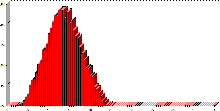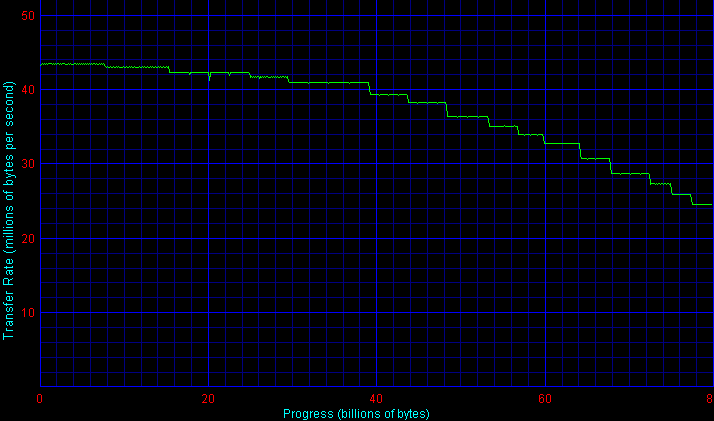|

Samsung’s 7200 RPM performance-series drive has evolved into a 40 GB/platter unit designed to compete with other contemporary disks. Designated SpinPoint P40, the flagship SP8004 utilizes two platters to yield a flagship capacity of 80 gigabytes. Like much of the competition, Samsung specs the drive’s average read seek time at 8.9 milliseconds. Also standard is the unit’s 2-megabyte buffer.

Can the P40 break Samsung’s recent trend of lackluster performance? Let’s put it to the test and see how it fares!
Low-Level ResultsFor diagnostic purposes only, StorageReview measures the following low-level parameters: Average Read Access Time– An average of 25,000 random accesses of a single sector each conducted through IPEAK SPT’s AnalyzeDisk suite. The high sample size permits a much more accurate reading than most typical benchmarks deliver and provides an excellent figure with which one may contrast the claimed access time (claimed seek time + the drive spindle speed’s average rotational latency) provided by manufacturers. WB99 Disk/Read Transfer Rate – Begin– The sequential transfer rate attained by the outermost zones in the hard disk. The figure typically represents the highest sustained transfer rate a drive delivers. WB99 Disk/Read Transfer Rate – End– The sequential transfer rate attained by the innermost zones in the hard disk. The figure typically represents the lowest sustained transfer rate a drive delivers. |
For more information, please click here.
|
Note: Scores on top are better. |
|
|||||||||||||||||||||||||||||||||
|
|
||||||||||||||||||||||||||||||||
SP8004 Average Read Service Time |
SP8004 Average Write Service Time
|
||||||||||||||||||||||||||||||||
The SpinPoint P40 delivers an average read access time of 13.6 milliseconds, approximately the same as that of its predecessor, the SpinPoint P20. Subtracting 4.2 milliseconds to account for the rotational latency of a 7200 RPM drive yields a measured seek time of 9.4 milliseconds… 0.5 ms off of Samsung’s claim. As a result, the drive’s seek time is in line with offerings from Western Digital but trails the impressive seeks delivered by Maxtor’s latest drive.
An average write service time of 14.5 milliseconds for the P40 is again similar to Samsung’s previous offering. Such a score once more lags Maxtor’s drive while pacing those from Western Digital.
|
Note: Scores on top are better. |
|
|||||||||||||||||||||||||||||||||
|
|
||||||||||||||||||||||||||||||||
SP8004 Transfer Rate
|
|||||||||||||||||||||||||||||||||
Outer-zone transfer rates for the P40 weigh in at 43.4 MB/sec, enough to best offerings from Maxtor and Seagate but trailing the 49 MB/sec of the category-leading Western Digital drives. When considering inner-zone rates, the Samsung slides a bit, ceding ground to Seagate while maintaining par with the DiamondMax.
Let’s turn now to high-level desktop performance.
Single-User PerformanceStorageReview uses the following tests to assess non-server use: StorageReview.com Office DriveMark 2002– A capture of 30 minutes of actual computer productivity use that exactingly recreates a typical office-style multitasking environment. The applications include: Outlook XP, Word XP, Excel XP, PowerPoint XP, Calypso (a freeware e-mail client), SecureCRT v3.3 (a telnet/SSH client), CuteFTP Pro v1.0 (an FTP/SSH client), ICQ 2000b), Palm Hotsync 4.0, Gravity 2.3 (a Usenet/newsgroups client), PaintShop Pro v7.0, Media Player v8 for the occasional MP3, and Internet Explorer 6.0. StorageReview.com High-End DriveMark 2002– A capture of VeriTest’s Content Creation Winstone 2001 suite. Applications include Adobe Photoshop v5.5, Adobe Premiere v5.1, Macromedia Director v8.0, Macromedia Dreamweaver v3.0, Netscape Navigator v4.73, and Sonic Foundry Sound Forge v4.5. Unlike typical productivity applications, high-end audio- and video- editing programs are run in a more serial and less multitasked manner. The High-End DriveMark includes significantly more sequential transfers and write (as opposed to read) operations. |
StorageReview.com Bootup DriveMark 2002– A capture of the rather unusual Windows XP bootup process. Windows XP’s boot procedure involves significantly different access patterns and queue depths than those found in other disk accesses. This test recreates Windows XP’s bootup from the initial bootstrap load all the way to initialization and loading of the following memory-resident utilities: Dimension4 (a time synchronizer), Norton Antivirus 2002 AutoProtect, Palm Hotsync v4.0, and ICQ 2000b.
StorageReview.com Gaming DriveMark 2002– A weighted average of the disk accesses featured in five popular PC games: Lionhead’s Black & White v1.1, Valve’s Half-Life: Counterstrike v1.3, Blizzard’s Diablo 2: Lord of Destruction v1.09b, Maxis’s The Sims: House Party v1.0, and Epic’s Unreal Tournament v4.36. Games, of course, are not multitasked- all five titles were run in a serial fashion featuring approximately half an hour of play time per game.
For more information, please click here.
|
Note: Scores on top are better. |
The SpinPoint P40’s StorageReview.com Office DriveMark 2002 of 261 I/Os per second delivers an impressive gain of 36% when contrasted with its own predecessor. Unfortunately the increase isn’t quite enough to bear down on the twin-performing Maxtor D740X and Seagate’s Cuda IV, both of which the Samsung trails by about 12%. The margin only widens when contrasting the P40 vs. WD’s category-leading WD1200BB.
A similar situation arises in the SR High-End DriveMark 2002. Though the P40 delivers a whopping 53% improvement over the P20, it still trails drives from the competition. The margin between the P40 vs. the Maxtor and Seagate units is much more modest however … around 5%. The Caviar WD1200BB remains out of reach for Samsung’s drive.
When it comes to a typical Windows XP bootup sequence, the P40 is on par with Maxtor’s drive. The D740X isn’t exactly a stellar performer here, however, as Seagate’s ‘Cuda IV differentiates itself here by pulling substantially ahead. WD’s disk, however, outraces all.
Finally, in the Gaming DriveMark 2002, the situation is quite similar to that of the Office DriveMark- the P40 trails the D740X and ‘Cuda IV and really lags the WD1200BB.
Multi-User PerformanceStorageReview uses the following tests to assess server performance: StorageReview.com File Server DriveMark 2002– A mix of synthetically-created reads and writes through IOMeter that attempts to model the heavily random access that a dedicated file server experiences. Individual tests are run under loads with 1 I/O, 4 I/Os, 16 I/Os, and 64 I/Os outstanding. The Server DriveMark is a convenient at-a-glance figure derived from the weighted average of results obtained from the four different loads. StorageReview.com Web Server DriveMark 2002– A mix of synthetically-created reads through IOMeter that attempts to model the heavily random access that a dedicated web server experiences. Individual tests are run under loads with 1 I/O, 4 I/Os, 16 I/Os, and 64 I/Os outstanding. The Server DriveMark is a convenient at-a-glance figure derived from the weighted average of results obtained from the four different loads. For more information click here. |
|
Note: Scores on top are better. |
|
|||||||||||||||||||||||||||||||||
|
|
||||||||||||||||||||||||||||||||
In an interesting contrast to the SpinPoint P40’s desktop-performance improvements over the P20, it actually regresses slightly when it comes to highly-random server performance. The P40’s File Server DriveMark 2002 trails that of the P20 by about 4%. A smaller gap arises in the Web Server DriveMark 2002. Here the P40 lags by an insignificant 2%. Speaking of insignificance, despite consistently minute differences, all contenders perform similarly in server situations. Similarly well, or similarly poorly when contrasted with the average SCSI drive ;).
Legacy PerformanceeTesting Lab’s WinBench 99 Disk WinMark tests are benchmarks that attempt to measure desktop performance through a rather dated recording of high-level applications. Despite their age, the Disk WinMarks are somewhat of an industry standard. The following results serve only as a reference; SR does not factor them into final judgments and recommends that readers do the same. |
|
Note: Scores on top are better. |
|
|||||||||||||||||||||||||||||||||
|
|
||||||||||||||||||||||||||||||||
Heat and NoiseIdle Noise– The sound pressure emitted from a drive measured at a distance of 18 millimeters. The close-field measurement allows for increased resolution between drive sound pressures and eliminates interactions from outside environmental noise. Note that while the measurement is an A-weighted decibel score that weighs frequencies in proportion to human ear sensitivity, a low score does not necessarily predict whether or not a drive will exhibit a high-pitch whine that some may find intrusive. Conversely, a high score does not necessarily indicate that the drive exhibits an intrusive noise envelope. Net Drive Temperature– The highest temperature recorded from a 16-point sample of a drive’s top plate after it has been under heavy load for 80 minutes. The figures provided are net temperatures representing the difference between the measured drive temperature and ambient temperature. For more information, please click here. |
|
Note: Scores on top are better. |
|
|||||||||||||||||||||||||||||||||
|
|
||||||||||||||||||||||||||||||||
Samsung’s drives have historically excelled when it came to environmental issues such as noise and heat. With an objective idle noise of 44.5 dB/A @ 18 millimeters, the SpinPoint P40 pegs in quite well compared to Maxtor’s and WD’s drives. Seagate’s Barracuda ATA IV, however, bests all with its impressively lower noise floor.
Subjectively speaking, however, when other system noises are factored in, the difference between the ‘Cuda IV and P40 is not noticeable. Seeks are also unobtrusive. Make no mistake, the P40 continues Samsung’s tradition of quiet drives.
The P40’s net operating temperature of 17.8 degrees Celsius, while substantially higher than the very cool-running P20, nonetheless remains the coolest of the pack. One should have few problems in integrating the SpinPoint in all but the most cramped of cases.
ConclusionThe SpinPoint P40 represents a substantial improvement over its lethargic predecessors. As a result, I regret pointing out that the drive still doesn’t match up with current offerings from Seagate and Maxtor. Sure the WD1200BB outpaces all, but it’s also available only in 120 GB capacities. The P40, however, remains nonetheless challenged by similar capacity offerings in the Barracuda ATA IV and DiamondMax Plus D740X lines. |
The P40 performs like a very good 5400 RPM unit rather than competing with 7200 RPM drives; those looking for performance without WD’s 120 gigs or price are better off with the D740X or ‘Cuda IV. The P40’s improvements over the P20 hopefully signal renewed attention to performance by Samsung- let’s hope the next drive in the series goes for the gold!




 Amazon
Amazon